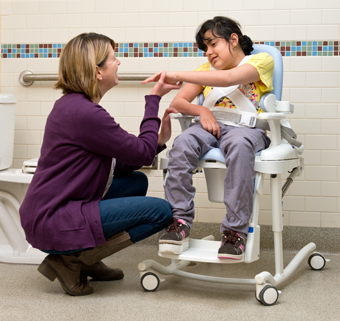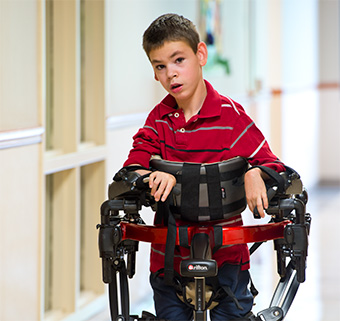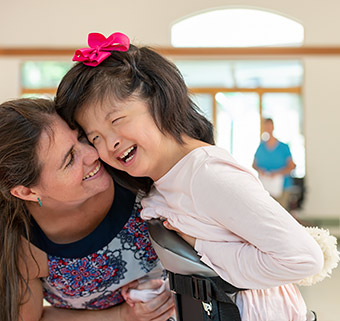The MOVE Program: An Update
| December 2011 For the past two decades Rifton has been involved with an outstanding organization devoted to people with profound disabilities. MOVE (Mobility Opportunities Via Education)® is an activity-based curriculum designed to teach individuals basic, functional motor skills needed for adult life. More recently, MOVE for Adults (Mobility Opportunities Via Experience)® provides a similar program to enable adults with movement disorders and developmental or complex disabilities to participate in activities, explore environments, and make informed choices.
For the past two decades Rifton has been involved with an outstanding organization devoted to people with profound disabilities. MOVE (Mobility Opportunities Via Education)® is an activity-based curriculum designed to teach individuals basic, functional motor skills needed for adult life. More recently, MOVE for Adults (Mobility Opportunities Via Experience)® provides a similar program to enable adults with movement disorders and developmental or complex disabilities to participate in activities, explore environments, and make informed choices.
Treating Movement Disorders and Multiple Disabilities
The MOVE program began in the mid 1980’s with the remarkable efforts of Linda Bidabe, a special education teacher working with students in her special education classroom in Bakersfield, CA. Astonishing outcomes with children whom the medical community thought would never walk inspired Linda to establish MOVE as an educational and therapy guide for the special needs school classroom. The first edition of the MOVE Curriculum for Children was published in 1991.
By providing a framework to coordinate services into a team effort, MOVE combines the natural body movements that occur during daily routines, with an instructional process that helps both children and adults acquire increased independence in sitting, standing and walking. Target motor areas are selected based on individual and family goals, and practice opportunities are integrated into meaningful, participatory activities. The results are astounding.
An Expanding Disability Support Program
 Current concepts in movement disorder science and motor learning theory substantiate the evident outcomes demonstrated by MOVE. The MOVE philosophy is continuing to gain acceptance in the field, and MOVE continues to expand. MOVE International conducts trainings throughout the US and internationally, as well as annually in Bakersfield, CA.
Current concepts in movement disorder science and motor learning theory substantiate the evident outcomes demonstrated by MOVE. The MOVE philosophy is continuing to gain acceptance in the field, and MOVE continues to expand. MOVE International conducts trainings throughout the US and internationally, as well as annually in Bakersfield, CA.
To sustain this progress and to continue to offer hope to even more people with motor and movement disabilities, MOVE International, a 501(c)3 public charity, and MOVE Europe, a registered charity, were created in 1994 (US) and 1999 (Europe).
Over the past 2 decades, MOVE has spread around the globe. Over 20,000 people in more than 25 countries have been trained to use the MOVE Program. These include therapists, special education teachers, adaptive PE instructors, instructional aides, as well as parents and other family members. In the United States, there are now 24 MOVE Model Sites where visitors can see MOVE in action. MOVE International’s expansion has also included the 2009 publication of the MOVE for Adults Program Manual and MOVE Toileting and Hygiene Program Guidebook. These efforts are transforming the lives of those with developmental, complex and multiple disabilities.
Training Teachers to Help People With Movement Disorders
In 1996, MOVE International established the certification of MOVE International Trainers (MITs). These MITs are available to provide MOVE Trainings throughout the US, in order to extend Linda Bidabe’s reach to more people. In 2011, there are more than 260 MITs qualified to conduct MOVE Trainings.
MOVE trainings are for individuals as well as for locations interested to fully utilize the MOVE Program at their school or center. Trainings are also necessary to re-certify the MOVE Trainers, keeping them up-to-date on movement disorder treatments. All these trainings require materials, resources, and, of course, monetary coverage.
With difficulties in the recent economy, MOVE International is meeting the challenge to establish the organization on an independent, sustaining foundation. The next years will be important, as MOVE International makes its final steps toward independence as a viable independent entity.
Linda Bidabe, writing about the immediate challenges facing MOVE, stated it best in the 2011 MOVE Newsletter:
“Every day our children and adults with severe disabilities prove they can learn if we know how to teach. We need to expand our MOVE Program sites and give all people the opportunity to sit, stand, walk, transition, communicate and grow to live as independently as possible. We can only do this as a team, so please share your thoughts with us. Thank you for your fantastic support. Let’s keep MOVING forward!”
To learn more about MOVE visit http://www.move-international.org.




